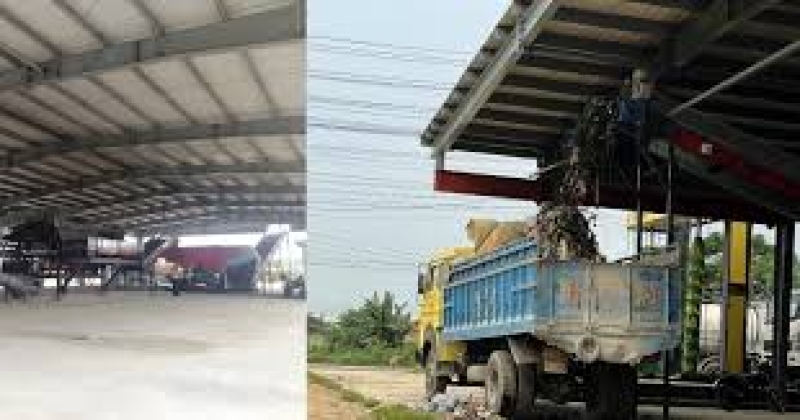- CA Yunus pays homage to Liberation War martyrs on Victory Day |
- Bangladesh capital market extends losing streak for second day |
- Bangladesh celebrates Victory Day Tuesday |
- 'Different govts presented history based on their own ideologies': JU VC |
Sylhet Sets Benchmark in BD’s Sustainable Waste Management

Amid Bangladesh’s mounting urban waste crisis, Sylhet City Corporation (SCC) has set a new benchmark in waste management with the establishment of the country's first state-of-the-art Material Recovery Facility (MRF). This pioneering initiative, developed in partnership with LafargeHolcim Bangladesh, aims to eliminate plastic and polythene waste and revolutionize how the city tackles its growing waste problem.
At a cost of Tk 15.30 crore, the facility is located at the Lalmatia Dumping Ground and marks a major step forward in the country's efforts toward sustainable waste management. The MRF promises to serve as a model for the entire nation.
Tackling an Escalating Waste Crisis
SCC’s conservancy workers collect approximately 375 tonnes of waste daily, all of which is transported to the Lalmatia landfill. Over the years, this eight-acre site has accumulated an estimated 800,000 tonnes of waste, posing severe environmental and health risks.
Mohammad Ekleem Abdeen, Chief Waste Management Officer at SCC, acknowledged that previous initiatives had failed to provide long-term solutions. However, he expressed optimism that the new MRF would drastically improve waste management in the city and reduce the environmental footprint of urban waste.
A Sustainable Approach to Waste Disposal
LafargeHolcim’s GeoCycle program is integral to the project, utilizing its Chhatak cement plant—the only facility in Bangladesh capable of producing clinker from imported alternative materials. The partnership, formalized through a Memorandum of Understanding (MoU) signed in September 2022, has laid the foundation for a system that prioritizes sustainability. Construction of the MRF began shortly thereafter, and operations officially commenced in May 2024.
Every day, over 60 tonnes of waste are transported from Lalmatia to the Chhatak cement plant for processing. The plant's capacity is set to increase in the coming years, helping to address the region's waste management challenges.
Tackling Non-Degradable Waste
The MRF separates non-degradable waste, such as plastic and polythene, which is then sent to the cement plant for co-processing. The waste is incinerated at temperatures of around 1,500°C, ensuring that it is fully processed without leaving harmful residues or contributing to environmental pollution.
The existing waste at Lalmatia is expected to take seven to eight years to clear, with GeoCycle’s current annual waste processing capacity standing at 100,000 tonnes. However, the company plans to expand this capacity significantly to meet future demand.
A National Model for Sustainability
Nur Azizur Rahman, Chief Engineer at SCC, lauded LafargeHolcim’s GeoCycle technology for its pivotal role in the city’s vision for a cleaner, more sustainable future. LafargeHolcim Bangladesh’s CEO, Mohammad Iqbal Chowdhury, emphasized that GeoCycle is the only waste management method approved by the Department of Environment.
LafargeHolcim currently provides waste management services to various public and private organizations across Bangladesh, with aspirations to support other city corporations in replicating this successful model.
A recent delegation from Narayanganj City Corporation visited the MRF and the Chhatak cement plant to learn more about the technology and explore potential collaborations in the future.
Call for Nationwide Adoption
Former SCC Mayor Ariful Haque Chowdhury, who played a pivotal role in bringing the MRF project to life, emphasized that while past efforts had fallen short, this new initiative offers a practical, effective solution. He called on the government to ensure the continued operation of the facility and urged other city corporations in Bangladesh to adopt similar approaches.
The Need for Urgent Action
A report by the Asia-Europe Foundation reveals that 55% of Bangladesh’s waste is dumped in open areas, with much of it either left uncollected or burned. This contributes to severe environmental hazards, including blocked drainage systems and frequent flooding even after minor rainfall. Additionally, Dhaka’s poor waste management has been identified as a major factor contributing to the city’s status as one of the most polluted in the world, according to a UNFPA report.
Experts stress that raising awareness and promoting sustainable waste management practices are critical to addressing the country’s waste crisis. As Bangladesh’s urban population grows, finding effective waste disposal solutions is essential to creating a cleaner, healthier environment.
Sylhet’s innovative waste management model offers a glimmer of hope. If adopted nationwide, this sustainable approach could transform urban waste management across Bangladesh, paving the way for a cleaner, more sustainable future for generations to come.

